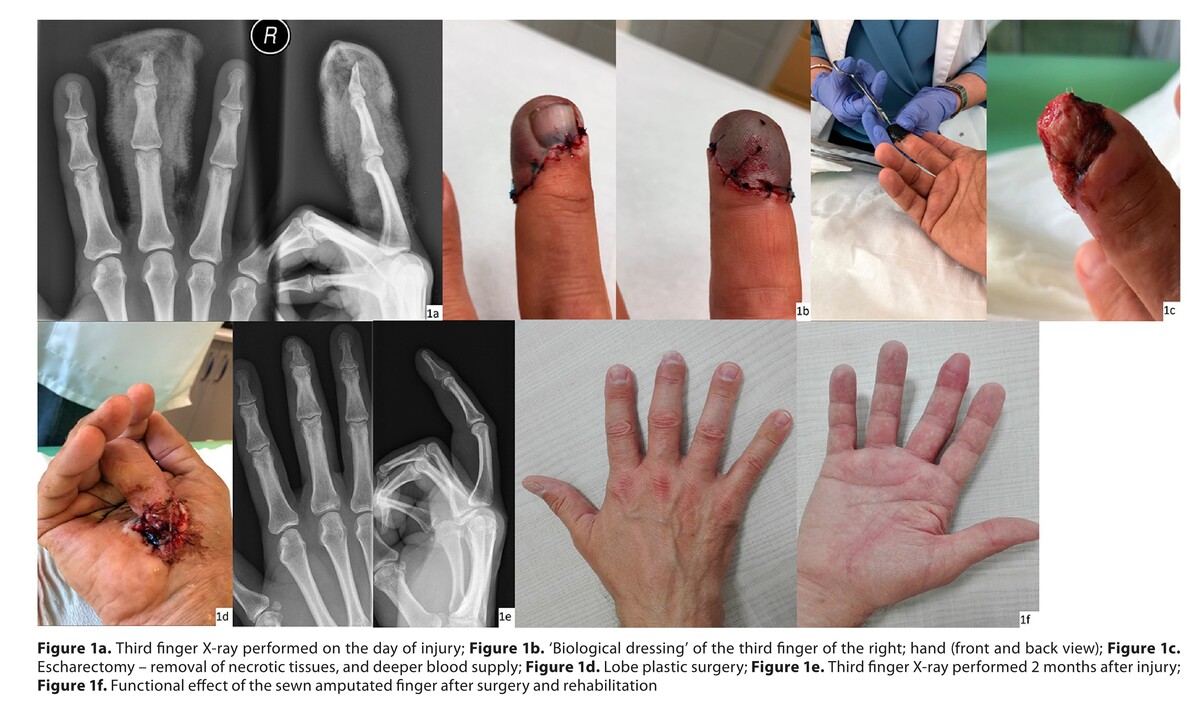Online first
Current issue
Archive
Special Issues
About the Journal
Publication Ethics
Anti-Plagiarism system
Instructions for Authors
Instructions for Reviewers
Editorial Board
Editorial Office
Contact
Reviewers
All Reviewers
2024
2023
2022
2021
2020
2019
2018
2017
2016
General Data Protection Regulation (RODO)
CASE REPORT
Rehabilitation after replantation of a non-work-related finger amputation without vascular
anastosmosis – case report
1
Department of Rehabilitation, Medical University of Warsaw, Warsaw, Poland
2
Department of Internal Medicine, Endocrinology and Diabetes, Medical University of Warsaw, Warsaw, Poland
3
Department of Rehabilitation, National Institute of Geriatrics, Rheumatology and Rehabilitation, Warsaw, Poland
Ann Agric Environ Med. 2024;31(3):446-449
KEYWORDS
TOPICS
- Exposure to physical hazards associated with the use of machinery in agriculture and forestry: noise, vibration, dust
- Work-related accidents and injuries in agriculture, forestry, food industry and wood industry: incidence, causes, social aspects and prevention
- State of the health of rural communities depending on various factors: social factors, accessibility of medical care, etc.
ABSTRACT
Work in agriculture carries the risk of trauma as a result of mechanization (farm equipment and machinery), location of cultivated areas, and multi-functionality. In agriculture, the hands were the most affected parts of the body which sustained injury. Successful suturing of a finger initially disqualified from replantation is rare. The case is presented of a 55-year-old patient who had a non-work-related finger amputation. In a surgical centre not belonging to the reference ones in plastic surgery in Poland, a doctor with six months of surgical experience performed the replantation without vascular reconstruction (the amputated distal part of the finger served as a biological dressing). Despite the lack of vascular reconstruction and unfavourable prognosis, the amputated fragment of the finger maintained a partial blood supply. Subsequent flap surgery in the plastic surgery department, and rehabilitation of the patient due to finger contracture, led to functional recovery of the finger.
REFERENCES (13)
1.
Mucci N, Traversini V, Lulli LG, Baldassarre A, Galea RP, Arcangeli G. Upper Limb’s Injuries in Agriculture: A Systematic Review. Int J Environ Res Public Health. 2020;17(12):4501.
2.
Reid DBC, Shah KN, Eltorai AEM, et al. Epidemiology of finger amputations in the united states from 1997 to 2016. J Hand Surg Glob Online. 2019;1:45–51.
3.
Yaffe MA, Kaplan FT. Agricultural Injuries to the Hand and Upper Extremity. J Am Academy Orthopaedic Surg. 2014;22(10):605–613.
4.
Neinstein RM, Dvali LT, Le S, Anastakis D.J. Complete digital amputations undergoing replantation surgery: a 10-year retrospective study. Hand (N Y). 2012;7(3):263–266.
5.
Chen J, Huang Y, Liu Z. Analysis of the factors affecting survival in digital replantation. Int J Clin Exp Med. 2017;10(3):5445–5448.
6.
Yu H, Wei L, Liang B, Wang J, Yang Y. Nonsurgical factors of digital replantation and survival rate A metaanalysis. Iniadn J Orthop. 2015;49(3):265–271.
7.
Atkins SE, Wintertona RIS, Kay SP. (v) Upper limb amputations: Where, when and how to replant. Mini-symposium: Hand trauma. 2008;22(1):31–41.
8.
Prsic A, Friedrich JB. Postoperative management and rehabilitation of the replanted or revascularized digit. Hand Clin. 2019;35(2):221–229.
9.
Ugurlar M, Kabakas F, Purisa H, Sezer I, Celikdelen P, Ozcelik IB. Rehabilitation after successful finger replantation. North Clin Istanb. 2016;3(1):22–26.
10.
Barbato B, Salsac AV. Finger and thumb replantation: From biomechanics to practical surgical applications. Hand Surg Rehabil. 2020;39(2):77–91.
11.
Li YS, Chen CY, Yang SW, Tarng YW. Cross-finger subdermal pocketplasty as a salvage procedure for thumb tip replantation without vescular anastomosis: a case report. J Int Med Res. 2018;46(9):3717–3723.
12.
Charpentier K, Loisel F, Menu G, Feuvrier D, Obert L, Pluvy I. Long-term functional results of digital replantation: A survey of 28 patients. Hand Surg Rehabil. 2019;38(6):375–380.
13.
Pasek J, Pasek T, Cieślar G, Sieroń A. Physical medicine after limb transplantation. Therapeutic effects of physical procedures in the treatment of limb transplantation after cut-off by a threshing machine – Case report. Ann Agric Environ Med. 2018;25(2):241–243. doi:10.26444/aaem/75112.
Share
RELATED ARTICLE
We process personal data collected when visiting the website. The function of obtaining information about users and their behavior is carried out by voluntarily entered information in forms and saving cookies in end devices. Data, including cookies, are used to provide services, improve the user experience and to analyze the traffic in accordance with the Privacy policy. Data are also collected and processed by Google Analytics tool (more).
You can change cookies settings in your browser. Restricted use of cookies in the browser configuration may affect some functionalities of the website.
You can change cookies settings in your browser. Restricted use of cookies in the browser configuration may affect some functionalities of the website.



